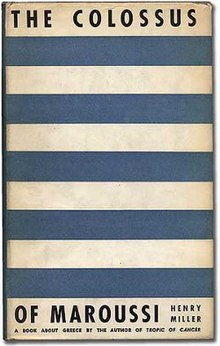The Colossus of Maroussi
 First edition | |
| Author | Henry Miller |
|---|---|
| Country | United States |
| Language | English |
| Genre | Travelogue |
| Publisher | Colt Press |
Publication date | 1941 |
| ISBN | 978-0-8112-1857-3 |
The Colossus of Maroussi is an impressionist travelogue by American writer Henry Miller that was first published in 1941 by Colt Press of San Francisco. Set in pre-war Greece of 1939, it is ostensibly an exploration of the "Colossus" of the title, George Katsimbalis, a poet and raconteur. The work is frequently heralded as Miller's best.
Background[]
In 1939, American writer Henry Miller left Paris, his home of nine years, as the Nazis began to take action in Europe and the outbreak of the Second World War loomed. In need of rejuvenation, he traveled to Greece at the invitation of his friend, British writer Lawrence Durrell, who lived in Corfu. Miller had already published what are considered some of his best-known works, including Tropic of Cancer, Black Spring, and Tropic of Capricorn.[1]
Miller drew his Colossus from events that occurred and landscapes he encountered while living for nine months in Greece. His portrayal of poet Katsimbalis and the country is tempered by the outbreak of the Second World War, which forced him to leave for the United States in December 1939.[2] Miller wrote the book in New York, and it reflects his resentment at having to return to America, as well as his feeling of isolation there.[2]
Content[]
The light of Greece opened my eyes, penetrated my pores, expanded my whole being.
— Henry Miller [3]
Miller travels in Athens, Crete, Corfu, Poros, Hydra and Delphi. As he describes these places, he also portrays Greek writer George Katsimbalis (the "Colossus" of the book's title). Among other characters are Lawrence Durrell, his first wife Nancy, and Theodore Stephanides. Some critics said that the Colossus is more of a self-portrait of Miller himself.[4] They have also noted the influence of D. H. Lawrence and Ernest Hemingway as expressed in this book.[1]
Critical reception[]
Critics consider this to be Miller's best, a view which the author also held.[2][5][6][7] Pico Iyer describes the novel as an "ecstatic ramble".[8] Will Self depicts Miller in the novel as "a relentless fabulist who advances solipsism to the status of one of the fine arts."[4]
References[]
- ^ a b Rayner, Richard (25 July 2010). "Paperback Writers: Henry Miller's Grecian days". Los Angeles Times. Archived from the original on 11 October 2018. Retrieved 14 August 2021.
- ^ a b c George Wickes (3 June 1966). Henry Miller - American Writers 56: University of Minnesota Pamphlets on American Writers. University of Minnesota Press. p. 33. ISBN 978-0-8166-0386-2. Retrieved 21 October 2012.
- ^ Miller, Henry (18 May 2010). The Colossus of Maroussi (Second ed.). New Directions Publishing. p. 210. ISBN 978-0-8112-1857-3. Retrieved 31 May 2013.
- ^ a b The Colossus of Maroussi By Henry Miller, Introduction by Will Self, , pp.10-11.
- ^ Alden Whitman, "Henry Miller, 88, Dies in California," New York Times, June 9, 1980.
- ^ Vidal, Gore (9 September 1988). "From outlaws to intriguers". The Times Literary Supplement. p. 979. Archived from the original on 4 March 2016. Retrieved 14 August 2021.
- ^ Hoffmann, Andy (2007). "On The Colossus of Maroussi: A Meditation on the End of War" (PDF). Salt Flats Annual. Archived from the original (PDF) on 4 March 2016. Retrieved 14 August 2021.
- ^ Iyer, Pico. "Going Mad for Greece". The New York Review of Books.
External links[]
- The full text can be read here: Questia
- Works by Henry Miller
- Fiction set in 1939
- Novels set in the 1930s
- 1941 American novels
- American memoirs
- American autobiographical novels
- Literary memoirs
- American travel books
- Novels set in Crete